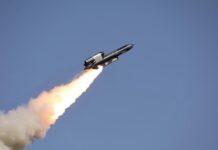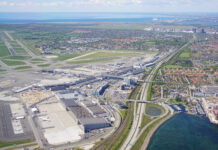On 5 May 2023, Ukrainian local news outlet Defense Express announced that Ukraine’s defence forces managed to shoot down a Russian Kh-47M2 Kinzhal air-launched ballistic missile at around 02:40 on 4 May over Kyiv.
As evidence, the news outlet provided two photographs purporting to show missile debris from the wreckage:
Defense Express showed a picture of the wreckage of the Kh-47M2 Kinzhal missile, which Russia used to try and hit Kyiv on the night of May 4. If confirmed, it will be the first successful interception of this hypersonic missile. https://t.co/AP8bZA21wI pic.twitter.com/dEC3eDJxga
— NOELREPORTS ???????? ???????? (@NOELreports) May 5, 2023
The debris shown in the 5 May pictures was identified as the unitary warhead assembly used in both Kinzhal and in the Iskander family of ballistic missiles by Ukraine Weapons Tracker in collaboration with a weapon specialist from Fenix Insight:
#Ukraine: Today, reports suggested that a Russian Kh-47M2 Khinzal air-launched ballistic missile was shot down by air defences over #Kyiv at 02:40 on May 4th- for the very first time.
The debris matches the unitary warhead assembly used in Kh-47M2 & Iskander-series missiles. pic.twitter.com/RjAcBQYEUN
— ???????? Ukraine Weapons Tracker (@UAWeapons) May 5, 2023
If indeed confirmed as Kinzhal rather than Iskander, this would mark the first successful interception of a Kinzhal. This has drawn a lot of attention, given that many people are under the impression that, as a hypersonic weapon, the Kinzhal is very difficult to shoot down. As such this has led various commentators in the defence sphere to question how this interception could occur and what would be capable of such an interception.
While the author would advise caution in drawing conclusions until better evidence emerges, he can at least explain how such an interception would be possible. However, explaining this properly first requires a brief crash course in hypersonics.
A Crash Course in Hypersonics
There are many misconceptions about what hypersonic missiles are, how they work, and what they are capable of. To begin with, most definitions of ‘hypersonic missile’ focus on the fact that such missiles can attain speeds of Mach 5 (1,715 m/s) or greater. What doesn’t get mentioned as often is that quite a lot of missiles already in service fit into this category without the fanfare of being ‘hypersonic’ – for instance, most ballistic missiles fit into this category.
To take a classic example, an Intercontinental Ballistic Missile (ICBM) such as Minuteman III, for instance, is estimated to possess an average speed of Mach 13.8 (4,762 m/s), when averaged out over the course of its flight. It would start its journey at a relatively slower speed during the early boost phase, while it is still inside the atmosphere, before reaching maximum speed at the end of the boost phase, once it has escaped the atmosphere, and sustaining this speed through the mid-course phase, where it can reach speeds estimated at around Mach 17.5 (6,000 m/s) to Mach 23.3 (8,000 m/s). This is incredibly fast, and by way of comparison, the latter figure is around the same speed as a High Explosive Anti-Tank (HEAT) shaped charge jet! The re-entry vehicle(s) then slow down from maximum speed during the terminal phase as they encounter increasing atmospheric drag the further they descend, though they remain at very high speeds for much of the descent. As such, although the ICBM is by definition a hypersonic weapon, most of the literature around ‘hypersonics’ doesn’t concern itself with ballistic missiles.
Instead, the majority of the literature concerns itself specifically with manoeuvring, endo-atmospheric hypersonic weapons. Generally speaking, these manoeuvring hypersonic weapons broadly fit into two categories:
- Hypersonic Cruise Missiles (HCMs) – these are air-breathing missiles which fly at endo-atmospheric altitudes, using a supersonic combustion ramjet (Scramjet) engine to enable sustained hypersonic flight while in the atmosphere. Due to being air-breathing, these missiles are limited to flying at altitudes where the air is sufficiently dense to power the engine – approximately 43 km down to around 15 km.
- Hypersonic Glide Vehicles (HGVs) – these are hypersonic gliders which are boosted to high endo-atmospheric altitudes (typically the high mesosphere) by a carrier rocket, before being released to glide unpowered through the atmosphere (typically the stratosphere) hypersonically. If required, the glide vehicle may ‘skip’ one or more times on the upper reaches of the atmosphere to increase its range, but would eventually pull into a sustained glide once they descend to their target. As they have no engine, they are effectively reliant on gravity and aerodynamics to sustain their speeds. As a rough approximation, the peak of their trajectory would be approximately 70 km, while their sustained glide altitude would be from about 40 km to 35 km.
As the name suggests, these weapons typically have greater capacity to manoeuvre in flight than ballistic missiles – although it should be noted that even ballistic missiles and/or their payloads can also have some capability to manoeuvre, as shown with various concepts which made it into service, such as the Manoeuvrable Re-entry Vehicle (MaRV), Multiple Independently-targetable Re-entry Vehicles (MIRVs), and the Fractional Orbital Bombardment System (FOBS). However, these tend to be less discussed than HCMs and HGVs, and as such, when most sources are talking about ‘hypersonic weapons’, they are typically referring to these latter two types.

The Kinzhal is neither of these, as it is essentially a modified variant of the 9M723 Iskander, a theatre ballistic missile (TBM) which is launched from an aircraft. Nonetheless, it benefits from some of the key characteristics of hypersonic weapons generally, most notably that it is very fast for the majority of its trajectory, making it difficult to detect, track, and shoot down – however, its range of manoeuvre is understood to be more limited than an HCM or an HGV, making its trajectory somewhat more predictable.
Along with the benefits of hypersonic flight come some negatives, with a particularly noteworthy example being the plasma sheath phenomenon. As hypersonic objects move through the atmosphere at speeds close to Mach 8-10, their interaction with the air at high speeds causes them to generate a plasma sheath around the body. This sheath is effectively maintained while the object remains sufficiently low in the atmosphere and at a high enough speed. This effect is dependent on atmospheric pressure as well as speed, and as such is most intense at lower altitudes. This plasma sheath causes attenuation of radio waves which are trying to pass through this layer, which effectively results in three operationally-relevant effects:
- It will weaken radio energy hitting the body and reflecting from it, which results in an effective decrease in the vehicle’s radar cross section (RCS). This phenomenon has previously been nicknamed ‘plasma stealth’.
- It also prevents an on-board radar seeker from being able to search for targets, since its own signals will be attenuated. [As a side note: an infrared seeker is also not a good alternative, since the hypersonic vehicle is surrounded by so much heat that it would cause image washout for the seeker.]
- It effectively prevents external communication with the missile, in essence meaning it cannot be directed from outside using radio control.
As a result of the latter two effects, in order to effectively perform targeting, using its seeker and/or GNSS guidance, the missile first needs to slow down to at least lower-hypersonic speeds (at least Mach 8, probably even lower for practicality). This makes the missile significantly easier to down when it is in this portion of its flight.

In fact, even if the plasma sheath phenomenon were not a factor, hypersonic objects are still typically forced to at least partially slow down as they descend to low altitudes, since the air becomes denser, and hence provides higher resistance and more friction. Attempting to fly at hypersonic speeds in this denser air is not only more difficult from a propulsion perspective, due to drag, but it also imposes significant material strain in the form of heat and pressure. The object will have a heat limit and a dynamic pressure limit – failure to stay within these limits risks destruction of the airframe.
Back to Kinzhal
With the above information in mind, it should be somewhat clearer that hypersonic weapons are not the invincible terrors they are sometimes claimed to be. Yes, they are typically far more difficult to shoot down than slower targets during their hypersonic phase of flight, but as shown – they do not necessarily always stay at hypersonic speeds.
Additionally, in the case of Kinzhal, the weapon is effectively a TBM, with a lower potential to change its heading in-flight than HCMs or HGVs, and thus making its trajectory somewhat more predictable if detected post-launch. The ultimate destination of the weapon is also made more predictable by the choice of targets near the end of the missile’s calculated trajectory – presumably Kyiv would only possess a limited range of targets the Russians would want to expend a Kinzhal on, and the Ukrainians probably know what these are.
Given all the above, it is far from implausible that a Kinzhal could be successfully engaged and downed. However, the highest likelihood for success in defeating it would likely require the missile to be engaged during the terminal phase, when it has slowed from its estimated maximum speed of around Mach 10, to a terminal speed well below this. Engaging in the terminal phase would in turn require that the right defence system is already pre-positioned very close to the target, to improve the odds of a successful intercept. This could also be further helped by radars detecting and continuously tracking the Kinzhal along its flight path toward the target, giving the air defenders more warning and more precise information on their target’s speed and direction.
Assessing the Evidence
Although the Ukrainian Air Force was reluctant to confirm the incident on 5 May, in the days following the incident, soft evidence to confirm the downing emerged in the form of official announcements by Ukraine’s Air Force on 6 May, and Ukraine’s Minister of Defence, Oleksii Reznikov on 7 May, followed by Pentagon Press Secretary Air Force Brigadier General Pat Ryder on 9 May. All three confirmed the missile in question was a Kinzhal and credited the PATRIOT system with the intercept. Finally, on 10 May, further hard evidence emerged, curiously in the form of footage showing Kyiv Mayor Vitali Klitschko presenting pieces of the wreckage to a journalist from Germany’s Bild newspaper.
The three pictures of the wreckage released on 5 May were identified by Ukraine Weapons Tracker as portions of the unitary warhead assembly used in both Kinzhal and in the Iskander family of ballistic missiles. Two pictures showed the rear of the assembly (a blackened hollow cylinder), while the third picture showed the front of the assembly, with a crack. The 10 May footage and photographs showed more angles of the unitary warhead assembly from the Kinzhal, along with several other components including a tailfin.
For clarity, the Unitary Warhead Assembly is an internal component of the missile which houses the singular warhead and fuze, and is located inside the front portion of the missile, as shown in the diagram below:

Many people on social media have rejected the claim that the pictures showed a Kinzhal component, because they made the mistake of thinking that the pictures show an external component. Indeed, several of them have proposed that the picture shows a BetAB-500ShP concrete-piercing bomb, which is designed to penetrate reinforced targets such as bunkers. This is incorrect, as the unitary warhead assembly has a different-shaped nose and holes thought to be for internal mounting points or standoffs, which are not present on the BetAB-500ShP, and would not be needed there.
However, despite this, the warhead does share some similarities in design to the BetAB-500ShP, which is possibly an indication that this version of Kinzhal is intended for use against hardened targets. This in turn may also explain why the Kinzhal was launched at Kyiv, which possesses various critical command posts in bunkers, with VIPs staffing them. An alternative interpretation for the warhead assembly’s thickness was floated by Mayor Klitschko, who stated that the thickness was due to thermal insulation shielding the warhead. However, this is also likely mistaken, given that the warhead assembly would already be partially shielded from heat by the missile’s skin and internal standoff spacing.
Although many of the criticisms levelled at the interception so far have been invalid, that does not mean there aren’t valid ones which can legitimately be raised. First among these is that thus far a portion of the evidence for the interception is reliant on official announcements – taken by itself, the imagery shown so far is insufficient evidence that a Kinzhal missile was downed by PATRIOT. Fundamentally, there are two main problems which remain based on the photographs released at the time of writing:
- All of the debris shown so far could belong to either a Kh-47M2 Kinzhal or a 9M723 Iskander.
- The best evidence to definitively prove that it is Kinzhal would be the distinctive rear, which has a boat tail and two short-chord fins which are not present on the Iskander.
- None of the debris displayed so far shows damage consistent with a SAM interception.
- Proving this would require assembling more debris from the wreckage, to demonstrate the portions of the missile directly affected by the interception. As it stands, it is unclear if the missile was downed or crashed due to another cause, such as a guidance failure.
Despite the above problems, in this author’s opinion, the balance of probability suggests that the interception probably did take place, however more evidence would need to be present to put the issue beyond doubt.
What Should be Expected in the Evidence?
With a PATRIOT interception, there would be different evidence depending on the missile used. As the Pentagon leaks have revealed, Ukraine should have access to both the PAC-2 GEM-T (ATM1T) and the PAC-3 (ATM2) missiles.
In the case of a PAC-3 interception, one would typically expect catastrophic destruction from direct impact at high supersonic speeds between a PAC-3 missile weighing 312 kg and a Kinzhal estimated to be around 4,000 kg. Even with the weight of both roughly halved to account for expended propellant, at the two missiles’ terminal speeds, the PAC-3 would have a kinetic energy close to 200 megajoules, while Kinzhal would have a kinetic energy of over 2,500 megajoules. By way of comparison, the latter is several hundred times the kinetic energy of a modern APFSDS penetrator fired from a tank gun. Consequently, following a collision between these objects, one would expect there to be almost nothing left of the front of the Kinzhal. So far evidence of this has not been shown, but it is possible that the missile could have struck a portion of the Kinzhal which has not been shown so far.
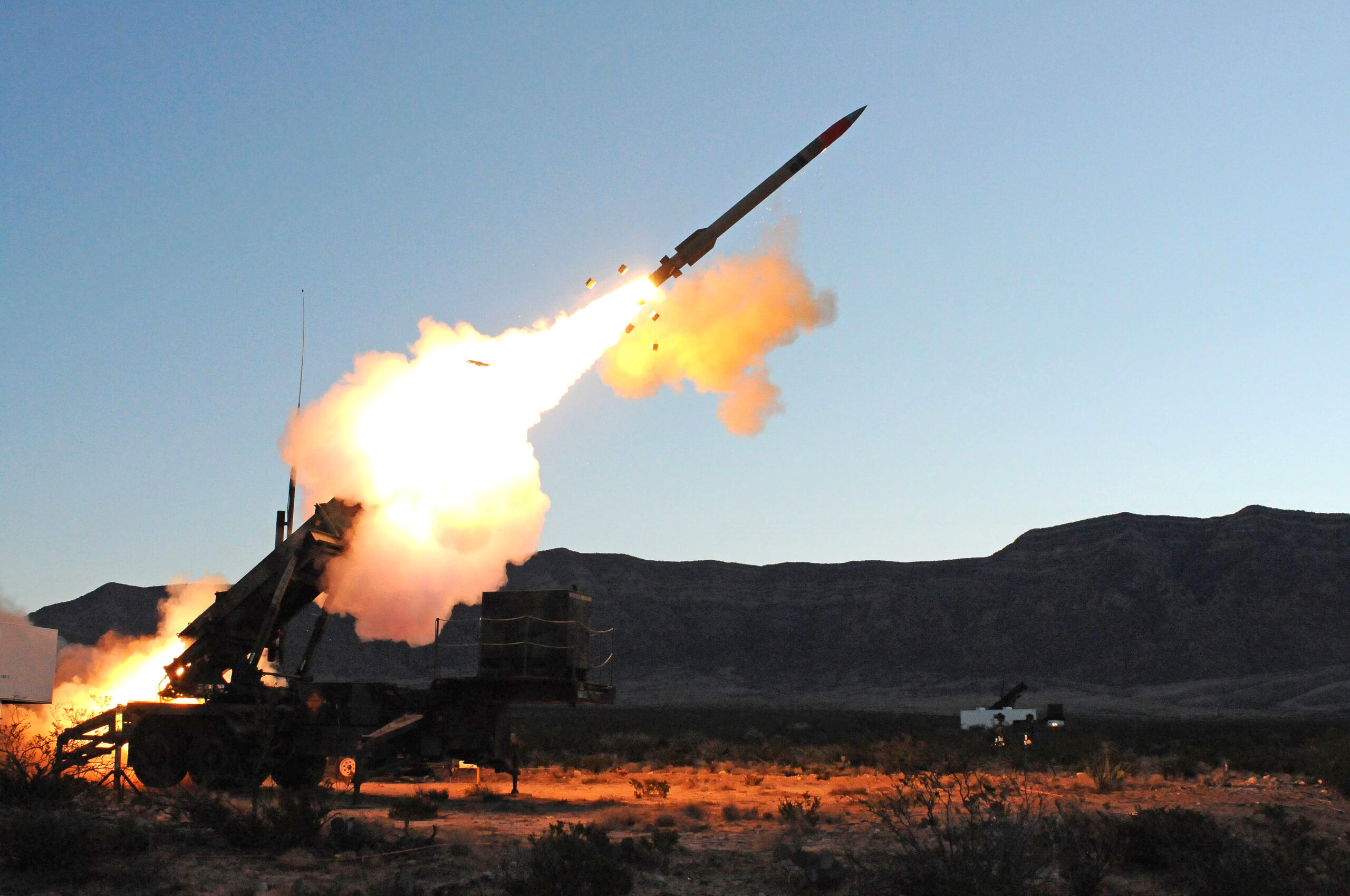
It would also theoretically be possible for some smaller holes or cuts, to also be present in a PAC-3 interception. Although the PAC-3 missile is primarily reliant on hit-to-kill for target defeat, it is also provided with a relatively small 8.2 kg warhead, known as the ‘lethality enhancer’. This contains 24 steel cycloid fragments arranged in two concentric circles, with each fragment weighing 95 g. Upon warhead activation, these cycloid fragments are released in a radial pattern at a relatively low expansion velocity due to the small quantity (around 350 g) of explosive material. As these rings of fragments expand outwards, they effectively serve to increase the diameter of the missile, and thereby improve the probability of successful target defeat. However, the lethality enhancer is typically only employed against non-ballistic targets, so against a Kinzhal the much more likely probability would be evidence of catastrophic damage at a single point of impact.
In the case of an interception by PAC-2 GEM-T, one would expect to see a fairly large quantity of small holes or larger cuts present in the outer casing of the missile caused by fragmentation from the large, 84 kg HE-FRAG warhead detonating in proximity to the Kinzhal. These are conspicuously absent, but it is possible that they simply hit other portions of the Kinzhal during the intercept, and these portions have not yet been shown. Further photos of debris from the wreckage would be needed to confirm this.
So What (Probably) Happened?
The interception was certainly technically possible for the reasons outlined above, and PATRIOT would be a good candidate for the interception, given that both missile variants operated by Ukraine (PAC-2 GEM-T and PAC-3) were intended to defeat ballistic missiles, which Kinzhal is an example of. In this author’s opinion, if the PATRIOT system was indeed the culprit, then the most likely candidate was probably the PAC-2 GEM-T (ATM-1T) missile, for a number of reasons.
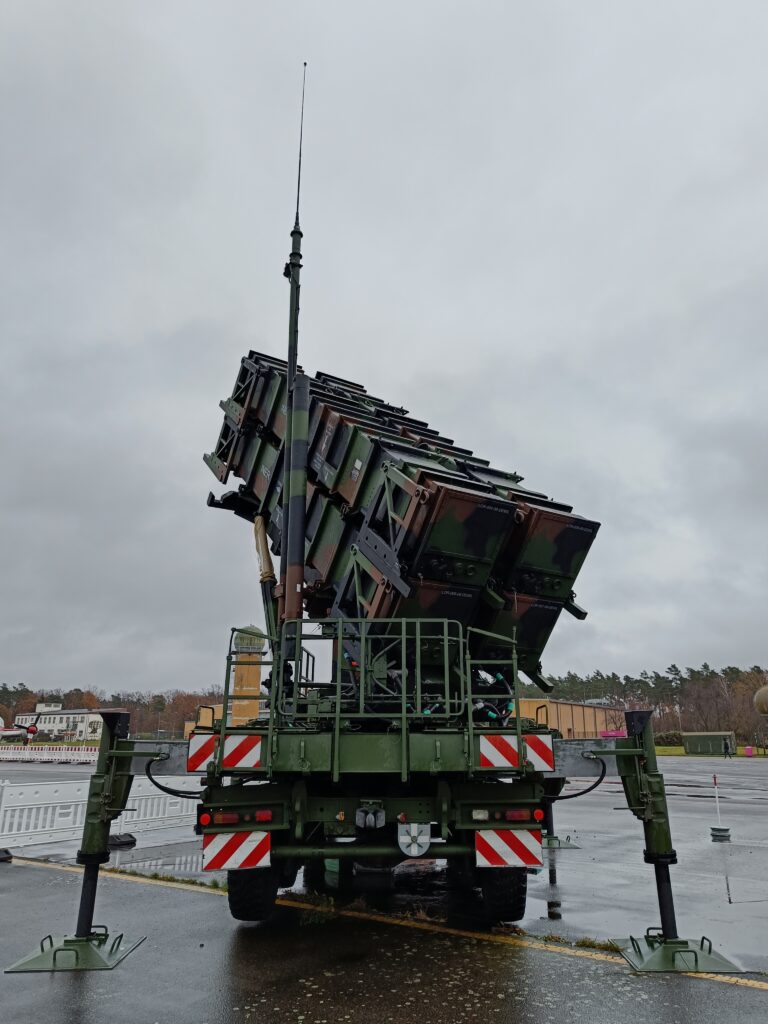
Credit: Mark Cazalet
Firstly, the damage does not appear consistent with what one would expect from a PAC-3 impact – the only damage visible is the fist-sized hole in the front of the unitary warhead assembly. This hole is far too small for a PAC-3 (which has a diameter of 255 mm) impact, and the damage is not extensive enough, since catastrophic damage would be expected in a PAC-3 collision. The fist-sized hole and cracks are therefore probably the result of collision with the ground, rather than the work of a SAM.
Secondly, the PAC-3 missile’s typical point of aim against ballistic missile targets is in the front portion of the missile, behind the nose. This is because on most missiles, the warhead would be situated here, so it makes for a logical point of aim when trying to guarantee defeat of the missile and minimise the risk of collateral damage, both of which PAC-3 aims to do.
It is possible that a PAC-3 could have missed the front and instead struck the middle or rear, however, in this scenario, the blackened rear of the warhead assembly would seem a bit strange. As evidenced by the Kinzhal wreckage from 14 September 2022, the warhead assembly seemed to show no signs of deflagration despite falling from a great height and the near-total destruction of the missile, and the missile propellant burning. Therefore, one can conclude that the explosive filler is probably fairly insensitive, meaning that in the 4 May 2023 wreckage, something had to introduce more energy directly into the warhead’s explosive filler to cause deflagration. It is also likely that if the PAC-3 had struck close enough to the warhead assembly to trigger deflagration of the explosive filler, then the damage to the warhead assembly would probably be catastrophic, and thus more obvious.
If anyone wondered what #crashed today in #russian Stavropol' region injuring 6 firefighters, you'd be very much surprised to know that it wasn't a "Ukrainian UAV", but a russian #Kinzhal missile. pic.twitter.com/QULK8kt2gJ
— LotA (@LotA_IL) September 14, 2022
Going further, it’s also likely that the warhead assembly was almost or fully intact when the deflagration of the explosive filler took place, since the front of the assembly is fairly ‘clean’ grey while the rear is blackened. This suggests that the point of impact or damage came from behind the warhead, probably toward the midsection or rear of the missile. This also further suggests that the hole in the front of the warhead assembly occurred due to impact with the ground – otherwise one would expect part of the front to also be blackened as a result of the deflagration. Furthermore, the majority of the missile itself was probably intact while the deflagration took place – the clue here is the fact that all components shown on the 10 May footage showed signs of having been burned, even the steering fins, which are way toward the rear. It’s quite possible that this was caused by the warhead deflagration passing through the body of the missile in flight.
An alternative explanation for the burn damage could be remaining rocket propellant, but one would expect most of it to have been expended by the time the missile was so close to its target. Additionally, the 14 September 2022 Kinzhal wreckage can be used as a comparison, since this incident notably featured combustion of the propellant but not the warhead. In the former case, the burned components showed mainly white soot deposition, while on the 4 May 2023 Kinzhal wreckage, the burned parts showed mainly black soot deposition.

Credit: Mark Cazalet
So, taking the above points together, what (probably) happened if the official announcements are accurate? From this author’s perspective, the most likely explanation is that the Kinzhal was probably intercepted by a PAC-2 GEM-T missile, which detonated in close proximity, showering the rear portion of the Kinzhal with fragments. This probably caused significant damage to the rear control surfaces and electronics, along with fragment(s) entering the warhead assembly either through the rear or by penetrating the assembly casing. This would then explain the deflagration of the explosive filler around the rear of the assembly, and fire causing damage along the length of the missile. Following this, aerodynamic stress on the missile structure probably caused the missile to break up into several pieces in mid-air, pushing the warhead assembly clear of the rest of the debris, and causing it to fall into the sports field. The impact with the ground probably caused the hole seen in the photograph of the front, along with the majority of the cracking, and of course the Astroturf seen jammed into the cracks. This should roughly fit the available evidence, but of course cannot be confirmed without further evidence.
Closing Thoughts
While it is certainly plausible that a PATRIOT conducted a successful intercept of a Kinzhal, this does not mean that the details of the incident have been proven beyond reasonable doubt. This article has posited a possible scenario to explain the available facts, but this is based on incomplete evidence and should be subject to revision if and when new evidence comes to light. Until more information surfaces, final judgement on the matter will need to be reserved. At least now it should be clear how such an interception could happen, and what signs to look for when determining the culprit.
Mark Cazalet





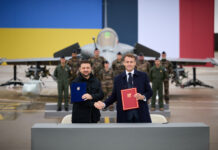
![Ukraine: Russian forces capture key towns [via Ugolok_Sitha Telegram Channel]](https://euro-sd.com/wp-content/uploads/2025/11/Russian-Motorbike-loaded_via-Ugolok_Sitha-Telegram-Channel-Kopie-218x150.jpg)


